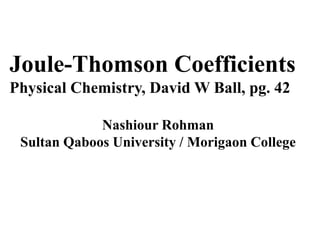
Joule-Thomson Coefficients.pptx
- 1. Joule-Thomson Coefficients Physical Chemistry, David W Ball, pg. 42 Nashiour Rohman Sultan Qaboos University / Morigaon College
- 2. Despite the fact that we have been dealing with numerous equations, they are all ultimately founded on the fundamental rule of thermodynamics and the equations of states. The definition of total energy and various modifications of that definition serve as the foundation for these concepts. Additionally, we have seen various instances where the specification of specific conditions, such as adiabatic, free expansion, isobaric, and isochoric, can simplify the equations of thermodynamics.
- 3. Conditions are any limitations placed on a process that make thermodynamics' mathematical calculations simpler. Exist any additional meaningful restrictions? The Joule-Thomson experiment, shown in Figure 2.10, describes another helpful constraint based on the first law of thermodynamics. On one side of a porous barrier, an adiabatic system is built up and a gas is introduced into it. This gas has an initial volume V1, a set pressure p1, and some temperature T1.
- 4. The final volume on this side of the porous barrier is zero because a piston forces all of the gas through it. As the gas diffuses to the opposite side of the barrier, where it will have a temperature T2, a fixed pressure p2, and a volume V2, a second piston moves out. At first, there is no volume on the right side of the barrier. It is known that p1 p2 because the gas is being driven past a barrier. It should be understood that the gas loses pressure as it is driven from one side to the other, despite the fact that the pressures on either side are fixed.
- 5. Work on the gas is being done on the left side, which benefits the overall change in energy. The gas does function on the right side, negatively impacting the overall shift in energy. After the first piston is fully pushed in, the system's net work is as follows: We shall express U as the internal energy of the gas on side 2 minus the internal energy of the gas on side 1, as the system is adiabatic and q = 0, therefore Unet wnet.
- 6. Comparing the two wnet expressions: also rearrange The original definition of H, the enthalpy, is U + pV; hence, for the gas in this Joule-Thomson experiment, or, for the gas undergoing this process, the change in H is zero
- 7. It is known as an isenthalpic process because the enthalpy of the gas does not change. Which effects might this isentropic process have? The change in temperature is not zero, despite the fact that the change in enthalpy is. What is the temperature change that occurs along with the pressure drop in this isentropic process? What, then, is (T/p)H? This derivative can be measured experimentally with a device like the one shown in Figure 2.10.
- 8. The change in temperature of a gas with pressure at constant enthalpy is known as the Joule-Thomson coefficient JT. This definition's closest practical approximation is JT is exactly 0 for a perfect gas because enthalpy solely varies on temperature. (that is, at constant enthalpy, temperature is also constant). The Joule-Thomson coefficient is not zero for real gases, hence the gas will change temperature during the isentropic process. Keeping in mind
- 9. that the cyclic rule of partial derivatives This can be rewritten as and realising that JT is on the left side and that the heat capacity at constant pressure is the fraction's denominator, we obtain
- 10. Since (H/p)T is 0 for an ideal gas, this equation proves that JT is zero for ideal gases. But not for actual gases. Furthermore, using equation 2.35, we can determine (H/p)T for a real gas, which is a quantity (the change in enthalpy as pressure changes but at constant temperature) that is challenging or impossible to measure by direct experiment. This is possible if we measure JT for real gases and also know their heat capacities.